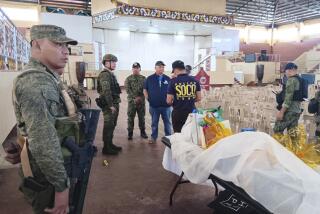Aquino Regime Seen as Target of Bombings
- Share via
MANILA — Top Philippine military officials said today that the four bombings in the nation’s capital in the past two days are part of “a bigger destabilization plan” by armed extremists of both the political left and right aimed at toppling President Corazon Aquino’s government.
The July 4 bombings of a U.S. government information agency and an American-financed international school in Manila were designed specifically “to create an atmosphere and climate of fear for the populace and also for the leaders of the government at all levels,” the armed forces vice chief of staff, Gen. Renato De Villa, said.
“These incidents are meant to create a feeling that the government cannot protect the people and to demoralize members of the (government’s) armed forces.”
Speaking at a breakfast forum today that included Aquino’s military chief of staff, Gen. Fidel V. Ramos, De Villa said the attacks appeared to be deliberately planned to cause only minor damage and no injuries. All of the explosions occurred at times when few people were around.
Too Soon to Fix Blame
“To us, all of this indicates only that the bombings, unlike (in) other countries where entire buildings fall down and scores are injured, are just designed to create that particular climate in society,” De Villa said, adding that it is premature to fix blame for the incidents.
But in a press conference Sunday afternoon, the military commander in charge of counterinsurgency in metropolitan Manila, Gen. Alexander Aguirre, blamed the bombings, in part, on right-wing “fanatics,” among them military deserters and renegades still loyal to deposed ruler Ferdinand E. Marcos.
“Their ultimate goal is to prevent Congress from convening,” Aguirre said, referring to the scheduled July 27 opening of the recently elected national legislature, which is dominated by pro-Aquino members. “It appears that their motivation behind these (bombings) could be fanaticism or money.”
The three July 4 bombings and a fourth that sent scores of couples fleeing in a remote part of a downtown park were all caused either by standard military issue fragmentation grenades or crude homemade “pillbox” bombs, authorities said, and they brought to 11 the number of bomb attacks in Manila in the past three weeks.
Several Groups Suspected
Col. Honesto Isleta, the military’s chief of public information, said he believed several diverse groups are behind the wave of bombings.
The attacks on U.S. and international targets, he claimed, are the work of a radical left-wing student group with ties to the New People’s Army, the 24,000-member military wing of the insurgent Communist Party of the Philippines.
“And then there are several groups--the ultra-rightists--who would like to ride on that in their continuing effort to destabilize the Aquino government--and not only to destabilize the administration, but to discredit the government itself,” Isleta said.
“It is really very easy to get a few grenades, assemble a few pillboxes, and it would only take a few men to drop these around,” Gen. De Villa said during the morning public forum today. “And in a metropolis of 8 million people, it would be very hard to track these people down.”
Gen. Ramos then appealed to the Philippine public to cooperate with military intelligence operatives who have been deployed throughout the city to stop the bombings by creating a citizens-based “early warning system.”
Ramos said that the nation’s Communist insurgency, which has claimed 1,300 lives since a temporary cease-fire expired last Feb. 8, remains the gravest threat to the Aquino government.
More to Read
Sign up for Essential California
The most important California stories and recommendations in your inbox every morning.
You may occasionally receive promotional content from the Los Angeles Times.













